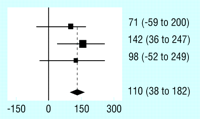This week in the BMJ
Volume 326,
Number 7401,
Issue of 7 Jun 2003
![[Down]](/icons/down.gif) Neuraminidase inhibitors treat and prevent flu
Neuraminidase inhibitors treat and prevent flu
![[Down]](/icons/down.gif) Quantitative ultrasound scanning increases detection of osteoporosis
Quantitative ultrasound scanning increases detection of osteoporosis
![[Down]](/icons/down.gif) Meta-analysis can effectively pool cost data for individual patients
Meta-analysis can effectively pool cost data for individual patients
![[Down]](/icons/down.gif) Young women accept Chlamydia screening in a contraceptive service
Young women accept Chlamydia screening in a contraceptive service
![[Down]](/icons/down.gif) Minorities are under-represented in RCTs
Minorities are under-represented in RCTs
![[Down]](/icons/down.gif) Poor education was associated with mortality in 1990s Russia
Poor education was associated with mortality in 1990s Russia
Neuraminidase inhibitors treat and prevent flu
Neuraminidase inhibitors are clinically effective for treating and preventing influenza, although evidence is limited for certain population groups and for all prevention strategies. Cooper and colleagues (p 1235) conducted a systematic review and meta-analysis of 17 randomised controlled trials of zanamivir and oseltamivir. They found that treating otherwise healthy adults and children with either drug reduces the duration of symptoms by 0.4-1.0 days. The treatment also lowers the risk of complications that require antibiotics by 29-43% when it is given within 48 hours of onset of symptoms. Given prophylactically, the drugs reduced the odds of developing flu by 70-90%.
![[To top]](/icons/back.gif)
Quantitative ultrasound scanning increases detection of osteoporosis
Quantitative ultrasound scanning is better than asking about risk factors for osteoporosis to select women for subsequent bone densitometry. Hodson and Marsh (p 1250) added quantitative ultrasound scanning to assessment of risk factors in 200 women aged 60-69 attending a nurse led primary care clinic. Ultrasound scanning performed better than risk factor inquiry for predicting osteoporosis. A combination of the two methods identified 90% of the women with osteoporosis and increased prediction for those without osteoporosis.

| |
DR TONY BRAIN/SPL
|
|
![[To top]](/icons/back.gif)
Meta-analysis can effectively pool cost data for individual patients
Meta-analysis of data on costs of treatment for individual patients can be used if sample sizes of individual studies are small. Bower and colleagues (p 1247) pooled the results of four trials of counselling in primary care that were underpowered to detect differences that may be of economic importance. Despite variation in the methods of the trials, analysis of data on costs was possible. The authors say, however, that it is a matter of debate whether secondary analysis provides a reasonably accurate estimate to inform policy and practice.
![[To top]](/icons/back.gif)
Young women accept Chlamydia screening in a contraceptive service
Young women find testing for Chlamydia trachomatis in a contraceptive service less stigmatising than attending a sexual health clinic. Moens and colleagues (p 1252) conducted a 12 month pilot programme testing the usefulness of opportunistic screening using a first catch urine sample. Urine testing was more acceptable to clients than using swabs. Nearly all of the young women (age 12-21) preferred to be contacted by mobile phone. In implementing the service, the authors are being more proactive in treating partners.

| |
BO VEISLAND/SPL
|
|
![[To top]](/icons/back.gif)
Minorities are under-represented in RCTs
In recent randomised controlled clinical trials, ethnic minorities were under-represented. Mason and colleagues (p 1244) searched for the number of South Asian participants (Indian, Pakistani, and Bangladeshi) from six phase III, multicentre, randomised controlled trials. They found that only 1.7% of participants were South Asians, even though the estimated population in Great Britain for this group is 3.4%. This under-representation might be due, the authors say, to investigators' bias, inappropriate strategies for recruitment, or the cost of translating information for participants. It is of ethical and scientific concern because there are ethnic differences in susceptibility to disease and response to treatments.
![[To top]](/icons/back.gif)
Poor education was associated with mortality in 1990s Russia
During the economic breakdown in Russia in the 1990s the greatest increases in mortality were among men with little education. Plavinski and colleagues (p 1240) used data from two prospective cohorts generated from voting lists in Leningrad (now Saint Petersburg) during the mid-1970s and 1980s. They found that men with university degrees were unaffected by the increased mortality, whereas men with less than high school education were most affected. Low education is a risk for mortality that cannot be fully explained by other risk factors, particularly during times of economic trouble.

| |
GLEB GARANICH/REX
|
|
![[To top]](/icons/back.gif)
Neuraminidase inhibitors treat and prevent flu
Quantitative ultrasound scanning increases detection of osteoporosis
Meta-analysis can effectively pool cost data for individual patients
Young women accept Chlamydia screening in a contraceptive service
Minorities are under-represented in RCTs
Poor education was associated with mortality in 1990s Russia



